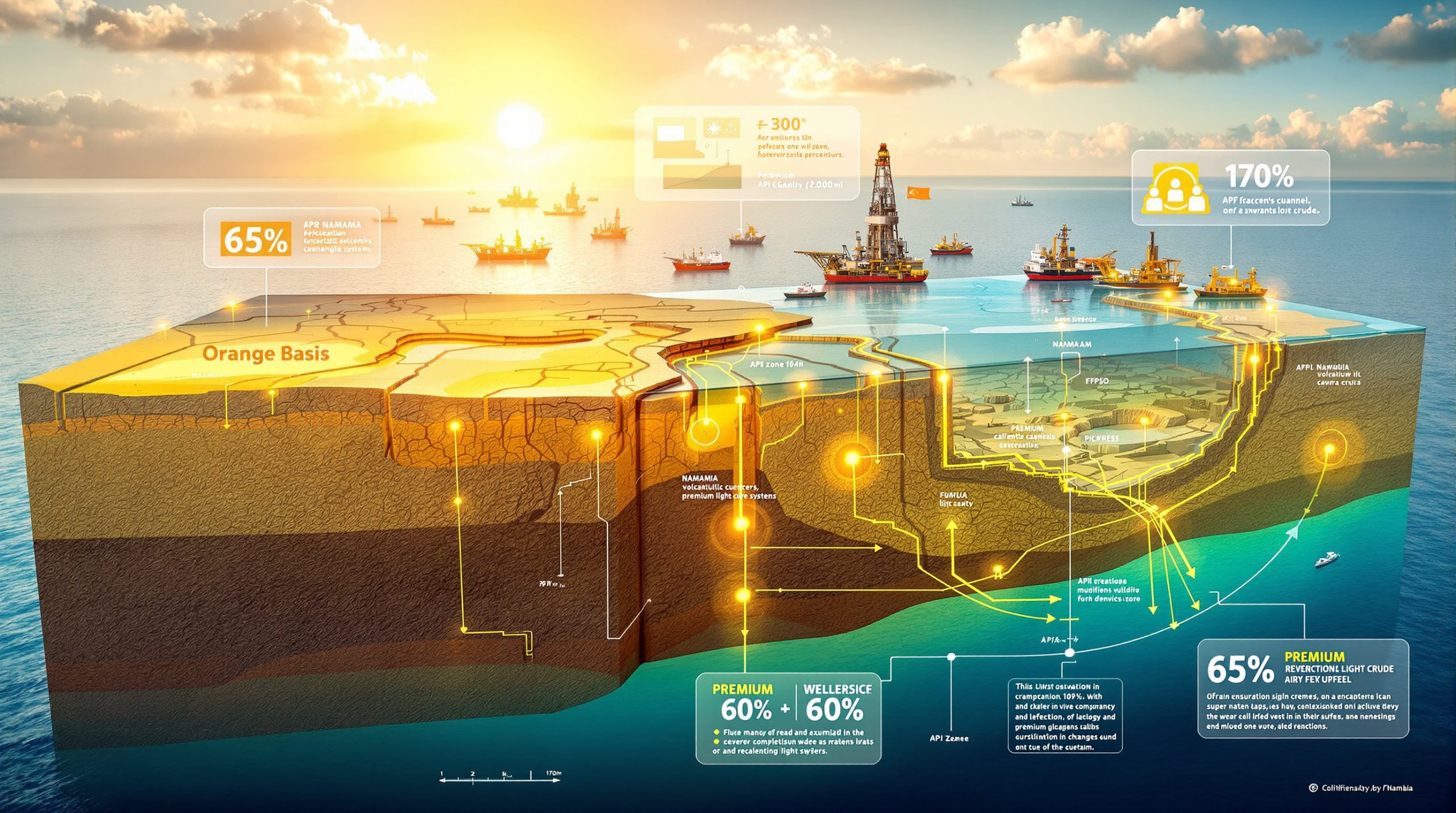The emergence of liquid hydrocarbons offshore Namibia represents more than a simple discovery announcement. Furthermore, it signals the maturation of a frontier petroleum system where traditional exploration methodologies must adapt to unconventional reservoir characteristics and multi-phase flow dynamics that differ fundamentally from West African analogue basins.
Deep beneath the waters of Namibia's Orange Basin lies a complex petroleum system that challenges conventional offshore development models. While most African offshore provinces are characterised by predictable sandstone reservoirs and straightforward thermal maturity profiles, Namibia's unique geological architecture presents a sophisticated interplay of fractured volcaniclastic formations and multi-zone hydrocarbon accumulations that demand specialised evaluation approaches.
Understanding Namibia's Offshore Petroleum Geology
How Do Namibian Reservoir Systems Compare to Global Standards?
The recent confirmation of liquid hydrocarbons offshore Namibia through BW Energy's Kharas-1 appraisal well has illuminated the distinctive characteristics of the Orange Basin petroleum system. Located approximately 130 kilometres southwest of the Namibian coast in 170 metres of water depth, the Kudu licence area spans 4,567 square kilometres within block PPL003, establishing it as one of southern Africa's most significant offshore exploration programmes.
The Kharas-1 well, which reached a total depth of 5,100 metres, successfully penetrated multiple reservoir intervals within a single wellbore design. This multi-zone testing approach represents a significant advancement over traditional single-target exploration wells, consequently enabling operators to evaluate diverse geological formations efficiently whilst minimising operational costs in frontier basins.
Key Reservoir Characteristics:
• Water depth: 170 metres (shallow offshore classification)
• Licence area: 4,567 square kilometres
• Maximum penetration: 5,100 metres total depth
• Distance from shore: Approximately 130 kilometres
• Historical context: Building on Kudu gas field discovered in 1974
The geological complexity observed in Kharas-1 demonstrates characteristics that distinguish Namibian formations from typical West African offshore plays. Unlike the predominantly clastic sequences found in the Niger Delta or Angola's Kwanza Basin, the Orange Basin exhibits a unique combination of turbidite and volcaniclastic reservoir systems that create dual-porosity flow mechanisms.
What Geological Factors Drive Liquid Hydrocarbon Accumulation?
The confirmation of liquid hydrocarbons offshore Namibia through the Kharas-1 well represents the first documented evidence of condensate and light oil within the Kudu block, fundamentally expanding the understanding of the Orange Basin petroleum system. In addition, the well intersected multiple reservoir intervals, with shallow turbidite reservoirs displaying dry-gas characteristics whilst deeper fractured volcaniclastic zones yielded condensate and light oil evidence.
Critical Petroleum System Components:
• Source rock maturity: Condensate compositions indicate thermogenic hydrocarbon generation
• Migration pathways: Multi-interval intersections suggest established vertical migration
• Trap integrity: Fractured volcaniclastic formations demonstrate structural closure capability
• Seal effectiveness: Dry-gas shows in shallow zones with liquid hydrocarbons at depth indicate compartmentalisation
The presence of both gas and liquid phases within a single wellbore penetration suggests a sophisticated petroleum system where thermal maturity windows have generated diverse hydrocarbon compositions. Furthermore, the deeper fractured volcaniclastic reservoir containing condensate and light oil confirms a working petroleum system with active generation and migration processes.
BW Energy's Chief Executive Officer, Carl Arnet, emphasised that the results confirm for the first time the presence of liquid hydrocarbons within the block, contributing significantly to understanding the broader petroleum system. However, the reservoir complexity identified requires additional appraisal work to fully assess the commercial potential of these discoveries.
The intersection of multiple hydrocarbon phases within single wellbore penetrations indicates thermal cracking processes that optimise liquid recovery potential in frontier basin developments.
Reservoir Engineering Challenges in Namibian Waters
Why Do Complex Reservoir Systems Require Advanced Appraisal Strategies?
The liquid hydrocarbons offshore Namibia discovered in the Kharas-1 well present engineering challenges that extend beyond conventional reservoir evaluation protocols. Moreover, the well's design to test multiple targets within a single penetration revealed significant reservoir heterogeneity that demands sophisticated assessment methodologies.
Technical Complexity Indicators:
• Permeability heterogeneity: Fractured volcaniclastic zones display variable flow characteristics
• Multi-phase behaviour: Condensate systems require specialised pressure-volume-temperature analysis
• Formation evaluation: Whole core acquisition programme implemented for detailed characterisation
• Connectivity assessment: Multi-zone penetration addresses lateral and vertical flow path evaluation
The acquisition of whole core samples from multiple reservoir intervals enables comprehensive petrophysical analysis essential for understanding fracture networks and matrix properties. Consequently, this data acquisition strategy represents industry best practices for characterising unconventional reservoir systems where porosity and permeability distributions cannot be reliably predicted from standard logging suites.
Reservoir Evaluation Methodology:
- Extended well testing to determine individual zone productivity
- Core analysis programmes for fracture characterisation and matrix properties
- Formation pressure testing across multiple reservoir intervals
- Fluid sampling protocols for phase behaviour determination
What Production Technologies Suit Namibian Reservoir Conditions?
The fractured volcaniclastic reservoirs identified in the liquid hydrocarbons offshore Namibia discoveries require completion technologies specifically adapted to heterogeneous permeability systems. Unlike conventional sandstone developments, these formations demand specialised approaches to optimise recovery from dual-porosity reservoirs where fractures provide primary flow capacity whilst matrix blocks contribute storage volume.
Carl Arnet indicated that the forward programme will focus on further high-value targets based on the presence of liquid hydrocarbons, gas, and learnings from the Kharas-1 appraisal. This staged approach recognises the need for comprehensive reservoir characterisation before selecting optimal production technologies.
Critical Production Considerations:
• Completion design optimisation for fractured volcanic sequences
• Artificial lift requirements for condensate recovery efficiency
• Multi-zone management to optimise production from stacked pay intervals
• Phase separation systems designed for gas-condensate production streams
Economic Viability Assessment Framework
How Do Development Costs Compare Across Offshore African Basins?
The economic assessment of liquid hydrocarbons offshore Namibia must account for the frontier basin status of the Orange Basin, where greenfield infrastructure requirements create capital intensity challenges not present in established petroleum provinces. The Kudu gas field, discovered in 1974 and delineated by seven subsequent wells, remained undeveloped for over 50 years, highlighting the economic sensitivity of Namibian offshore projects to fiscal terms and market conditions.
In this context, our latest oil price rally analysis demonstrates how global pricing dynamics significantly influence frontier basin development decisions. Furthermore, current natural gas trends show the volatile nature of hydrocarbon markets that affect project economics.
Infrastructure Development Requirements:
• Subsea systems: No existing pipeline infrastructure requires complete subsea development
• Processing facilities: Onshore or floating production systems needed for gas and condensate handling
• Export infrastructure: Pipeline connections or floating storage and offloading systems required
• Support services: Limited local offshore service capabilities increase operational complexity
The water depth of 170 metres in the Kudu field represents shallow offshore conditions that reduce installation complexity compared to deepwater developments. However, the distance of approximately 130 kilometres from shore creates logistical challenges for pipeline installations and operational support.
What Factors Influence Project Economics in Namibian Waters?
Critical Economic Variables:
• Fiscal regime competitiveness: Government royalty and tax structures impact project returns
• Local content requirements: Workforce development and supplier obligations affect capital costs
• Market access logistics: Transportation to international markets influences netback pricing
• Currency exposure: Namibian dollar exchange rate fluctuations impact local cost components
The confirmation of liquid hydrocarbons offshore Namibia improves project economics by diversifying revenue streams beyond gas sales, which traditionally face more complex marketing and infrastructure requirements in frontier regions. Additionally, US oil production decline insights highlight how global supply dynamics can positively impact pricing for new discoveries.
Resource Quantification and Reserve Classification
How Reliable Are Current Resource Estimates?
The recent discovery of liquid hydrocarbons offshore Namibia through the Kharas-1 well provides the first concrete evidence of oil and condensate potential within the Kudu licence area, though resource quantification remains in early stages pending additional appraisal activities.
Current Assessment Status:
• Proven reserves: Minimal due to early appraisal stage
• Probable reserves: Contingent on successful extended well testing
• Possible resources: Based on seismic interpretation and analogous formations
• Prospective resources: Undrilled prospects identified through 2023 seismic acquisition
Resource estimates in frontier basins typically demonstrate high uncertainty ranges until comprehensive drilling campaigns provide calibration data for geological models.
Reserve Classification Challenges:
- Limited well control with single appraisal penetration completed
- Reservoir heterogeneity requiring extensive delineation programmes
- Multi-phase fluid systems complicating recovery factor estimates
- Economic uncertainty pending development cost optimisation
Production Timeline and Infrastructure Requirements
What Infrastructure Developments Enable Commercial Production?
The development timeline for liquid hydrocarbons offshore Namibia depends critically on the completion of comprehensive appraisal programmes and infrastructure planning initiatives. BW Energy's forward programme focuses on additional high-value targets identified through 2023 seismic acquisition and learnings from the Kharas-1 well.
The global context of energy exports challenges demonstrates how infrastructure bottlenecks can delay project development. For instance, the exploration evolution trends show how technological advances can accelerate development timelines when properly implemented.
Development Sequence:
• 2025-2026: Extended appraisal drilling and reservoir characterisation
• 2026-2027: Final investment decisions contingent on commercial viability
• 2027-2029: Infrastructure development and installation campaigns
• 2029-2030: Production startup and initial ramp-up phases
Critical Infrastructure Components:
• Subsea production systems designed for multi-zone completions
• Pipeline infrastructure connecting to onshore processing facilities
• Gas processing units for condensate separation and stabilisation
• Export terminals enabling access to international markets
How Do Namibian Projects Compare to Similar Developments?
The Kudu gas field discovery in 1974, followed by seven delineation wells over subsequent decades, demonstrates the extended evaluation timelines typical of frontier basin developments. The recent confirmation of liquid hydrocarbons offshore Namibia represents a significant advancement in commercial viability assessment after 50 years of intermittent appraisal activity.
Development Timeline Benchmarks:
• Frontier basin developments: 6-8 years discovery to first production
• Established provinces: 3-5 years with existing infrastructure
• Namibian context: Extended appraisal requirements due to reservoir complexity
Risk Assessment and Mitigation Strategies
What Technical Risks Could Impact Development Success?
The liquid hydrocarbons offshore Namibia discoveries present technical risks characteristic of frontier basin developments, particularly in complex geological settings where reservoir performance cannot be reliably predicted from analogous fields.
Primary Risk Categories:
• Reservoir performance uncertainty in fractured volcaniclastic systems
• Completion effectiveness in heterogeneous permeability environments
• Phase behaviour complexity in condensate-bearing formations
• Infrastructure reliability in marine environments 130 kilometres offshore
Risk Mitigation Approaches:
- Extended well testing programmes to characterise individual zone productivity
- Core analysis initiatives for fracture network mapping and matrix characterisation
- Pilot production systems to validate reservoir performance models
- Weather-resistant specifications for harsh marine operational conditions
Future Exploration Potential
Where Are the Next High-Impact Opportunities?
The success of the Kharas-1 well in confirming liquid hydrocarbons offshore Namibia establishes a foundation for systematic exploration of analogous targets within the 4,567-square-kilometre licence area. Furthermore, the 2023 seismic acquisition programme identified multiple prospects with similar geological characteristics to the successful Kharas discovery.
Exploration Target Prioritisation:
• Step-out locations from proven Kharas-1 discovery
• Analogous structural trends identified through seismic interpretation
• Deeper reservoir intervals potentially containing additional hydrocarbon accumulations
• Turbidite channel complexes with established connectivity to source rocks
What Technologies Will Accelerate Future Discoveries?
Advanced Exploration Technologies:
• High-resolution seismic imaging for fracture system characterisation
• Multi-component seismic analysis to define reservoir properties
• Electromagnetic surveys for direct hydrocarbon detection
• Real-time formation evaluation during drilling operations
The complex reservoir architecture demonstrated in the liquid hydrocarbons offshore Namibia discoveries requires integrated geophysical and geological approaches that exceed traditional exploration methodologies. Consequently, machine learning applications in seismic interpretation and advanced drilling techniques for complex reservoir access represent critical technological enablers for future exploration success.
Disclaimer: This analysis contains forward-looking statements and resource estimates that involve significant uncertainties. Actual results may differ materially from projections presented. Readers should conduct independent analysis before making investment decisions in frontier exploration activities.
Ready to Capitalise on the Next Major Energy Discovery?
Discovery Alert instantly alerts investors to significant ASX mineral discoveries using its proprietary Discovery IQ model, turning complex exploration data into actionable insights for both traditional mining and energy sector opportunities. Begin your 30-day free trial today to position yourself ahead of the market and never miss transformative discoveries that could generate substantial returns.




